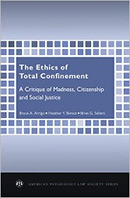The Ethics of Total Confinement: A Critique of Madness, Citizenship, and Social Justice

Authors: Bruce A. Arrigo, Heather Y. Bersot, and Brian G. Sellers
Oxford, UK; New York: Oxford University Press, 2011. 300p.
Reviewer: Bonita M. Veysey | September 2012
The Ethics of Total Confinement is an analysis of the cultural-philosophical underpinnings of the common modes of formal social control in modern day U.S. society. Using three examples from criminal justice practice, the authors analyze the effects of the punitive policies on the kept, the keepers and their watchers, and ultimately the heart and soul of the American public. The book analyzes legal decisions in regards to: (1) juvenile transfer, (2) solitary confinement of inmates with mental illnesses, and (3) long-term surveillance and civil commitment of sexually violent predators. The authors collected, reviewed and synthesized judicial opinions from state and federal district, appellate and Supreme Court cases. These opinions were analyzed in terms of the plain meaning content of the language of the decisions and the implicit meaning; that is, the underlying philosophy that guided these decisions. Using these examples, the authors critique U.S. society’s moral and ethical development. In the final section of the book, the authors make suggestions about how law and practice could support a community where all citizens are encouraged to fulfill their human potential.
In the critical tradition of the great classical ethicists, this book offers a broad challenge to criminal justice theorists and practitioners and the average citizen alike. The authors ask us to reflect on practices in the criminal justice system that appear not only to treat the guilty unnecessarily harshly, but by doing so affect the nature of society itself. Through the very behaviors of condemning, excluding, and dehumanizing individuals under correctional supervision, the agents of the state diminish their own humanity. Laws, rules and regulations compound the injury, and society as a whole is complicit in its own ethical destruction.
The authors provide a wonderful review of classical social ethics from Aristotle to Kant, from Rousseau to Mills. They present and discuss, “prevailing ethical theory, including: (1) ethical formalism and deontological prima facie duties; (2) consequentialism (consisting of ethical egoism, contractualism, and utilitarianism); and (3) Aristotelian virtue philosophy (featuring feminist care ethics)” (p.9). The highest ethical values derived from these theories seek what is best for victims, offenders and the general public. At the intersection of law, psychology and crime, dignity-focused psychological jurisprudence reflects these principles and is based upon relatively recent developments in the field, including commonsense justice (taking “into account the ordinary citizen’s notion of what is just and fair” [p.7]); therapeutic jurisprudence (the law’s ability to act as a healing agent); and restorative justice (the practices of reconciling victims and offenders). The authors use these ethical theories and principles as standards to evaluate and critique U.S. criminal justice practices through the evaluation of the language of their related judicial decisions.
The textual analysis strategy is interesting and provides a way to systematically uncover patterns of meanings. The authors analyze both the plain meaning and the manifest underlying philosophy that guide judicial decision-making. The authors conclude that courts consistently reflect utilitarian principles, deciding on behalf of the good of the many at the expense of the good of the few. While the analytic strategy is innovative and informative, I am not convinced that the conclusions are supported.
First, much of American jurisprudence is inherited from British common law. The organization and the behavior of courts have a long tradition. One of the basic tenets of judicial decision-making, in addition to the weighing of facts, is that decisions be based upon precedent. That is, prior court decisions and existing law provide guidelines for future decisions. Further, implicit in the decision-making process is the philosophy upon which decisions are built. Arguably, utilitarianism is the dominant philosophy for many court decisions. It is not surprising then, that decisions regarding these three issues reflect utilitarian principles.
Second, the selection of the sample of topics: juvenile waiver, segregation of inmates with mental illnesses, and the post-sentence control of sexually violent predators; is not described or justified. This is an intentional selection of highly visible and controversial topics that, in at least two cases, reflect the moral panic that results in the very kind of over-reaction that the authors rail against. Other choices of topics might result in different conclusions. For example, other case law applied to special populations exists that, in fact, reflect the court’s upholding the rights of the minority over that of the majority (e.g., ongoing suits on conditions of confinement, the right to treatment, and the exclusion of juveniles from receiving the death penalty).
Finally, while based in a historical review of ethics and the organization of societies, the book is somewhat ahistorical in regard to U.S. social justice policies. Largely ignoring changes in mental health and penal legislation over the past few decades, the selection and descriptions of the three exemplars gives the reader the impression of a society spiraling down ever more quickly into an inevitable Orwellian dystopia. Indisputably, America’s history with social justice has had its ups and downs. We have been in better and worse places in the past. However, the structure of American society has not changed substantially despite the many civil rights movements and their concomitant judicial decisions. Social stratification and differential opportunities persist, and the visible steps we have made toward a more inclusive society are often undermined by the pernicious actions of other social control institutions. There has never been a Golden Age of American society or any other society for that matter. The view that changes in how courts make their decisions can transform society is naive. The authors consistently point to a possible future where all citizens are encouraged to flourish without recognizing that this utopian vision presents just an alternative weltanschauung that is as enslaving as any other social arrangement.
I fully agree with the many of the premises upon which this book is based. As a society, we do appear to have lost our way. We have the highest incarceration rate of any nation in the world; reacting to single incidents out of fear far beyond a rational assessment of real risk and without regard to the harm caused to whole classes of people. While the foundations of the critique are sound, the authors’ argument is more of a polemic without much regard for the nuances and complexities of a society that has competing philosophies of individual freedom and the common weal; of laws that protect individuals from unnecessary coercion and those that protect society at large from certain classes of people (including those that serve as the exemplars for the critique).
Bonita M. Veysey, Ph.D., Rutgers University, School of Criminal Justice


